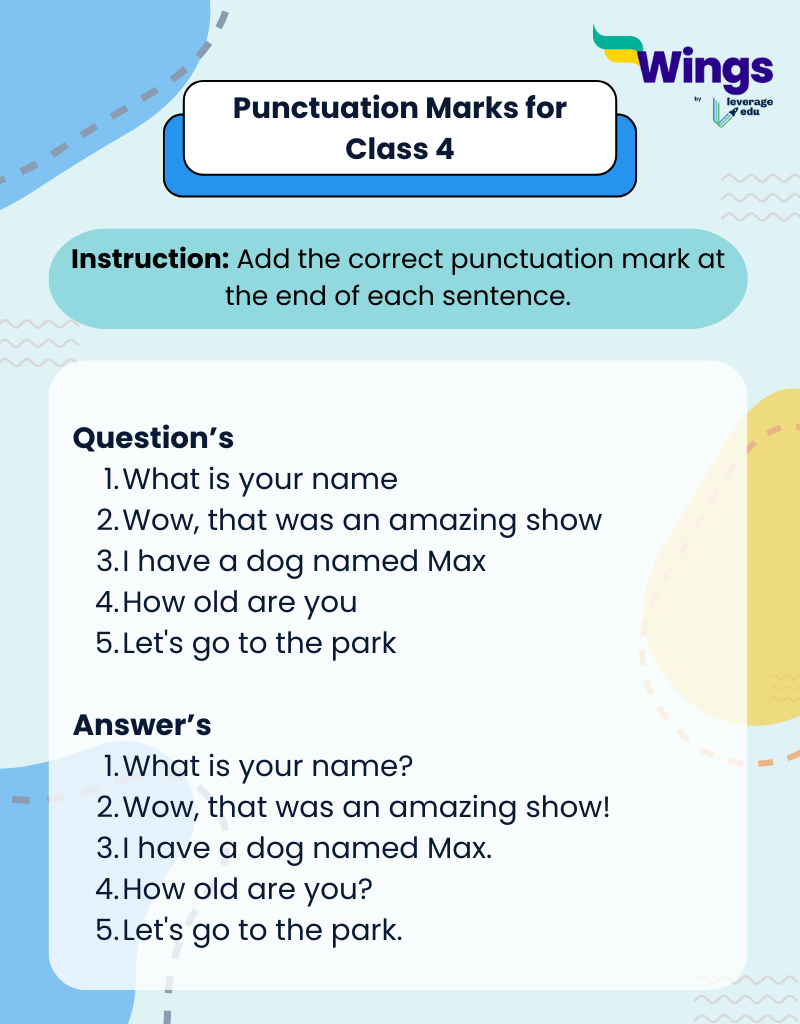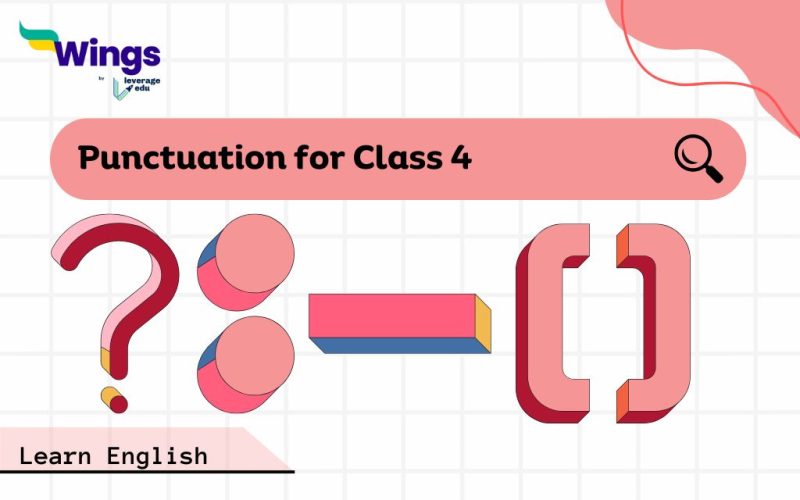Punctuation for Class 4: Understanding punctuation marks is important for students as it helps in placing these marks in the right place in a sentence. It helps to convey thoughts accurately, reducing the chances of errors. Here, we will understand what punctuation marks are and how they can help the students studying in grade 4. Also, explain the types of punctuation that are suitable for students, along with their examples in this blog henceforth.
This Blog Includes:
Click here to know all about Punctuation
What are Punctuation Marks for Class 4?
Punctuation marks are usually put in a sentence to get a clear way of understanding them. It is used in writing to split the sentences into different parts and make them easily readable. Various symbols are used to provide the correct meaning of the sentence in the writing form.
Using punctuation for Class 4 in particular, requires you to imagine the sentences and put the right symbol in the right place. After all, if there is no punctuation mark in a sentence then it will show no meaning. It would become hard to understand where the sentence starts and where it ends without a punctuation Mark.
Also Read: 19+ Quotation Marks Examples with Rules of Usage
Types of Punctuations for Class 4
The Punctuation for Class 4 is a basic grammar that students should focus on properly to understand in a better way. If it is taught imaginatively and interestingly then the students can get a perfect understanding of the topic.
Full Stop or Period
The Full Stop(.) is a kind of punctuation mark that is placed at the end of the sentence. It indicates that the sentence has been concluded. The full stop marks the end of a declarative sentence that is been concluded. It is also used in abbreviations and initials.
For Example:
- Mr. S. Ranganathan is a scientist.
- He is not coming back.
Capital Letters
The important thing about Capital letters is that they are placed at the start of the sentence. The first letter of the first word in a sentence is a capital letter. Words such as nouns, verbs, adjectives, and acronyms should be in capitalisation. Moreover, place, movie, book titles, locations, and languages must also start with capital letters.
For Example:
- The Lion is the king of the Jungle.
- He is going to London next week.
Question Mark
The Question Mark(?) is a type of punctuation mark that is used in interrogative sentences. When a question is asked and the person wants an answer for this question.
For Example:
- Why are you looking outside the window?
- When did you join the organization?
Comma
A Comma(,) is a punctuation mark that is used to separate the words or phrases in a sentence. It is a short pause that is used to show the division of the sentences. It also helps in separating the list of items.
For Example:
- Kolkata, Bengaluru, and New Delhi are some of the metropolitan areas of India.
- James, a very good chef, went to New York.
Colon
A colon(:) is mainly used to provide emphasis, introduce text or lists, present dialogue, and clarify composition titles. It is also used to explain series and definite time.
For Example:
- He wrote “Organizational Crisis Communication: A Multivocal Approach”
- Reporter: When will the new product launch?
Semi Colon
The semi-colon(;) is used for joining the two independent clauses that are linked to each other in the place of a coordinating conjunction and a comma.
For Example:
- Tim completed all the work; Kathrine did not finish hers.
- Steve is a good driver; moreover, he is smart.
Exclamation Mark
Exclamation Mark(!) is a punctuation that is used to showcase strong feelings and emotions. It is used with interjections and exclamatory sentences.
For Example:
- Wow! It is such a wonderful place.
- Don’t Talk, get out!
Hyphen
A hyphen(-) is used for joining the related parts of the word. They are commonly used with compound modifiers when it is coming before the modifying word.
For Example:
- His brother-in-law attended the wedding last night.
- Mr. Hudson wears old-fashioned clothes.
Apostrophe
An apostrophe( ‘ ) is a type of punctuation that is most commonly used to show omitted letters, possessive nouns, and plurals formation.
For Example:
- I’ve been waiting for her since morning.
- He is reading Charle’s book.
Brackets
Brackets ( ) help to enclose information, phrases, or words, that are to be added in a sentence. There are mainly two types of brackets: open brackets and closed brackets.
For Example:
- The International Cricket Council(ICC) headquarters are located in Dubai, United Arab Emirates.
- She has references to her old book(The Counsellor) in the new book.
Dash
The dash (—) is used to set out a phrase or word after the parenthetical remark or independent clause that breaks in the sentences. Never get confused between the hyphen(-) symbol and the dash (—) symbol as they are completely different.
For Example:
- Many children — living in hostels — do not know what home-cooked food feels like.
- The program will be organized from May 9 — 12.
Slashes
Slashes is a Punctuation Mark that is used to show two words that are more or less similar. It shows the availability of choices and options. Additionally, it is used in place of the conjunction ‘or’.
For Example:
- They will either play football/cricket.
- She is coming on Monday/Tuesday.
Punctuation Marks for Class 4 – Examples in Sentences
| Punctuation | Symbol | Example Sentence |
| Full Stop | . | I’m waiting for the bus to arrive. |
| Question Mark | ? | When are you coming to New York? |
| Comma | , | He is a clever, healthy man. |
| Colon | : | Sam plays four sports: Football, Golf, Tennis and Squash. |
| Apostrophe | ‘ | I’m waiting for the bus to arrive. |
| Hyphen | – | Her father-in-law is not arriving for the party. |
| Slash | / | The answer to the question is Yes/No. |
| Semicolon | ; | “The cookies were delicious; they were crispy and sweet.” |
| Capital Letter | A | They were visiting Banff National Park next week. |
| Dash | — | He is afraid of two things—Lizards and senior prom. |
| Bracket | ( ) | For more information see chapter “The Lion” (page 9). |
Punctuation Exercise for Class 4
Instruction: Rewrite the following sentence using appropriate punctuation marks (full stop, capital letter, question mark, comma, exclamation mark) wherever required:
- we travelled to Agra by bus
- i had stuffed paratha curd and pickles for lunch
- look the athlete is running
- mr Malhotra’s family is warm friendly and nice
- why do you need a new car
Answers Key
1. We travelled to Agra by bus.
2. I had stuffed paratha, curd, and pickle for lunch.
3. Look! the thief is running.
4. Mr. Malhotra’s family is warm, friendly and nice.
5. Why do you need a new car?

Bonus Exercise on Punctuation for Class 4
Here are some punctuation exercises for Class 4 students:
Exercise 1: Adding Full Stops
- Instructions: Add full stops to the end of these sentences.
- My favourite colour is blue
- I like to play with my dog
- We went to the park yesterday
- She is reading a book
- The cat sat on the mat
Exercise 2: Adding Question Marks
- Instructions: Add question marks to the end of these sentences.
- What is your name
- Where do you live
- Can you play with me
- Do you like ice cream
- How old are you
Exercise 3: Adding Exclamation Marks
- Instructions: Add exclamation marks to the end of these sentences.
- Wow, that’s amazing
- Help, I’m falling
- Look out, a car is coming
- Happy birthday
- Yippee, we won
Exercise 4: Adding Commas in Lists
- Instructions: Add commas where needed in these sentences.
- I like apples bananas and oranges
- We need milk bread and cheese
- She has a red blue and green dress
- He plays football basketball and cricket
- My favourite animals are dogs cats and rabbits
Exercise 5: Mixed Practice
- Instructions: Add the correct punctuation (full stop, question mark, exclamation mark, or comma) to these sentences.
- What is your favourite subject
- I love to read books
- Ouch, that hurts
- We need pencils erasers and notebooks
- Where are you going
Exercise 6: Sentence Correction
- Instructions: Correct the punctuation in these sentences.
- my name is Sarah
- how old are you
- I like to play soccer
- we need apples bananas oranges
- help me
Answer Key:
Exercise 1: 1. blue. 2. dog. 3. yesterday. 4. book. 5. mat.
Exercise 2: 1. name? 2. live? 3. me? 4. cream? 5. you?
Exercise 3: 1. amazing! 2. falling! 3. coming! 4. birthday! 5. won!
Exercise 4: 1. apples, bananas, and oranges. 2. milk, bread, and cheese. 3. red, blue, and green dress. 4. football, basketball, and cricket. 5. dogs, cats, and rabbits.
Exercise 5: 1. Subject? 2. books. 3. hurts! 4. pencils, erasers, and notebooks. 5. going?
Exercise 6: 1. My name is Sarah. 2. How old are you? 3. I like to play soccer. 4. We need apples, bananas, and oranges. 5. Help me!
FAQs
A class 4 student can read the punctuation mark chapter in their Grammar books by seeing the images of it.
Hyphen’s symbol(-) is shorter than Dashes (—) and is used in between words and prefixes for making compound words. However, dashes are used in between clauses or phrases.
The two important punctuation marks are Fullstop(.) and comma(,).
Slashes are used to show two words that are more or less similar. It shows the availability of choices and options. Additionally, it is used in place of the conjunction ‘or’. For Example: You can write Dear Sir/Madam in the letter.
The best way to learn is to practice!
Read lots of books and pay attention to how authors use punctuation.
Try writing your own sentences and stories.
Ask your teacher or a grown-up to help you if you’re not sure.
Look at these two sentences:
“Let’s eat, Grandma!” (This means you’re inviting Grandma to eat.)
“Let’s eat Grandma!” (Oh no! This means you’re going to eat Grandma!)
Imagine reading a page with no punctuation. It would be a long, confusing block of words! Punctuation helps to:
Make sentences clear and easy to read
Show where ideas begin and end
Add expression to writing
This was all about the English grammar punctuation marks for Class 4 and more in grammar. Hope you understand the concept and know how to proceed. You can also follow the Learn English page of Leverage Edu for more exciting and informative blogs.
-
This post is a great resource for helping Grade 4 students understand punctuation! It’s clear that learning the right way to use punctuation marks will help them express their ideas accurately. The examples will likely make it easier for students to grasp the concepts.
-
Hi Sahil,
I am glad you found this resource helpful. Here are some more blogs on punctuation that you can provide to Grade 4 students or any student learning about punctuation:
https://leverageedu.com/explore/learn-english/punctuation-quotation-marks-examples/
https://leverageedu.com/explore/learn-english/apostrophe-examples/
https://leverageedu.com/explore/learn-english/punctuation-inverted-commas-uses-with-examples/
https://leverageedu.com/explore/learn-english/punctuation-exclamation-mark-examples/
-
 One app for all your study abroad needs
One app for all your study abroad needs















 60,000+ students trusted us with their dreams. Take the first step today!
60,000+ students trusted us with their dreams. Take the first step today!


2 comments
This post is a great resource for helping Grade 4 students understand punctuation! It’s clear that learning the right way to use punctuation marks will help them express their ideas accurately. The examples will likely make it easier for students to grasp the concepts.
Hi Sahil,
I am glad you found this resource helpful. Here are some more blogs on punctuation that you can provide to Grade 4 students or any student learning about punctuation:
https://leverageedu.com/explore/learn-english/punctuation-quotation-marks-examples/
https://leverageedu.com/explore/learn-english/apostrophe-examples/
https://leverageedu.com/explore/learn-english/punctuation-inverted-commas-uses-with-examples/
https://leverageedu.com/explore/learn-english/punctuation-exclamation-mark-examples/